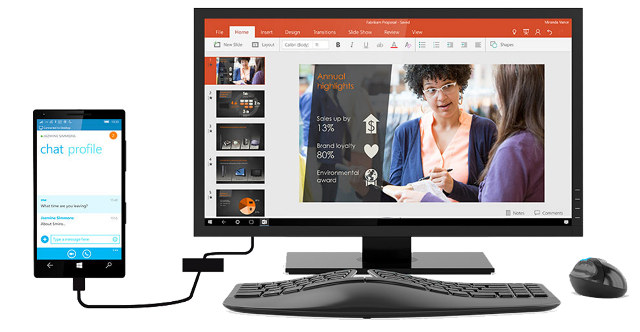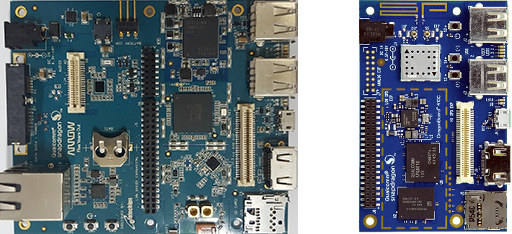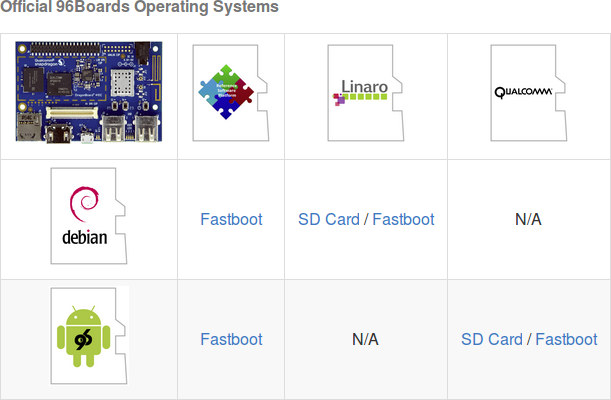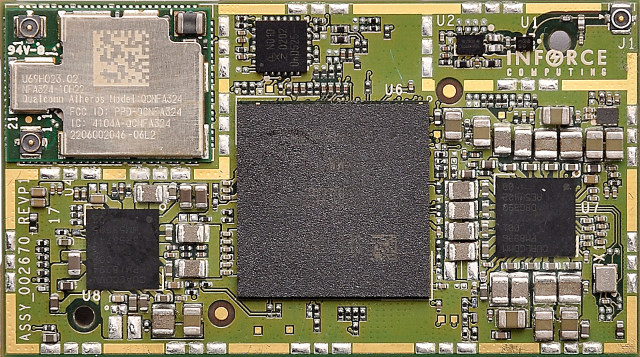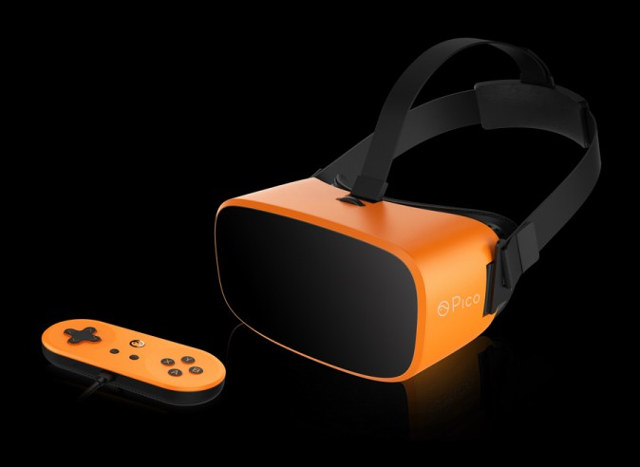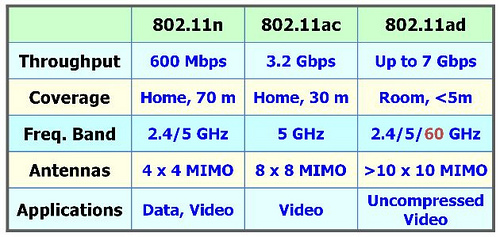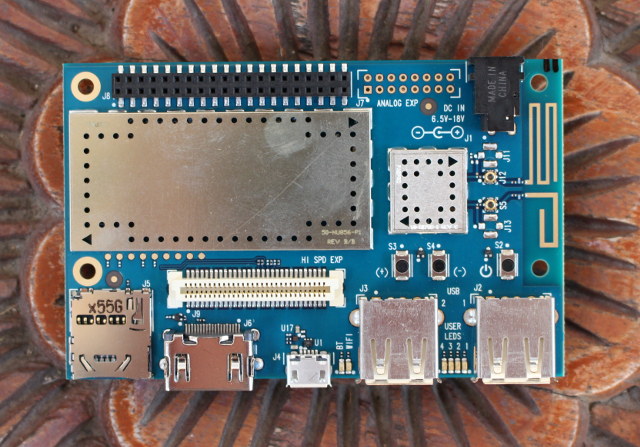Mobile and PC convergence is slowly happening both on Ubuntu with devices like BQ Aquaris M10 Ubuntu Edition tablet, and various Windows 10 Continuum smartphones. The most affordable offering is likely to come from mainland China vendors, such as Moly PcPhone 6″ smartphone based on Qualcomm 617 octa-core Cortex A53 processor with 3GB RAM, and running Windows 10 Continuum. Moly PcPhone specifications: SoC – Qualcomm Snapdragon 617 Octa core Coretex A53 processor @ 1.5 GHz with Adreno 405 GPU System Memory – 3 GB RAM Storage – 32 GB flash + micreo SD slot up to 200 GB Display – 6″ Full HD (1920×1080) LTPS display; Gorilla Glass 3 Cellular Connectivity Dual SIM Dual Standby, Adaptive SIM Slot 2G GSM: Band 2/3/5/8 3G WCDMA: Band 1/6/8/9/19 4G FDD-LTE: Band 1/2/3/4/7/8/9/19/26/28B 4G TDD-LTE: Band 38/40/41 Wireless Connectivity – Wi-Fi: 802.11 a/b/g/n/ac, Bluetooth 4.0, and NFC Camera – 13MP auto-focus rear camera […]
Qualcomm DragonBoard 600c 96Boards Development Board Includes Ethernet and SATA
A few weeks ago, I was informed that some code about DB600c board powered by Qualcomm Snapdragon 600 processor (APQ8064T) was making it into mainline Linux, and more recently I found a website listing DragonBoard 600c with a low resolution picture of the board. While we don’t have the complete specifications yet, the form factor of the board is quite interesting, as we’ll find the typical 96Boards CE form factor on the right, and some extra interfaces on the left with Ethernet and SATA. It turns out, as we’ll see below, it’s perfectly compliant (hardware wise) with 96Boards CE “Extended Version” specifications. Preliminary specifications of DragonBoard 600c board: SoC- Qualcomm Snapdragon 600 (APQ8064 Fusion 3) quad-core Krait processor @ 1.7 GHz with Adreno 320 GPU @ 400MHz System Memory – 1GB or more RAM (TBD) Storage – eMMC Flash + micro SD slot + SATA port Video Output – HDMI […]
Debian on DragonBoard 410c Development Board
I purchased Qualcomm DragonBoard 410c development board last year, and first tested it and run some benchmark on the 96Boards compliant hardware with Android. I found that it was still work-in-progress, and decided to wait before trying Debian on the board. I’ve now done so, and will report by experience installing Debian Linux, playing with the board, and running Phoronix benchmarks to compare it to other ARM Linux boards. Installing Debian on DragonBoard 410c The first challenge is to navigate through the documentation that is not always clear or up-to-date. I eventually ended up on DragonBoard 410c Wiki on Github. You then have to decided which image you want. While there are two official operating systems with Android and Debian, you can three “entities” releasiong their own images. For Debian specifically, you have the Linaro image, and Reference Platform Build (RPB) image. I could not find any changelog or known […]
Inforce 6601 micro SoM Snapdragon 820 System-on-Module Embeds WiFi, Bluetooth and GPS
We’ve already seem Intrinsyc’s Snapdragon 820 development board and module, but there’s now an alternative thanks to Inforce Computing 6601 micro SoM which is pin-to-pin compatible to the company’s earlier Inforce 6401 and Inforce 6501 Micro SOMs, also based on Qualcomm Snapdragon processors, and works with the same SYS6501 carrier board. Inforce Computing 6601 Micro SoM specifications: SoC – Qualcomm Snapdragon 820 (APQ8096) quad core ARMv8 processor with two “Gold” cores up to 2.2 GHz, two “Silver” cores up to 1.6 GHz, Adreno 530 GPU with support for OpenGL ES 3.2, OpenCL 2.0, and Vulkan, as well as Hexagon 680 DSP up to 825 MHz System Memory – 4GB LPDDR4 @ 1866 MHz Storage – 64GB UFS 2.0 gear 3 flash up to 5.83Gbps, 1x micro SD card 3.0 interface for support for to HS400, optional eMMC 5.1 flash. Connectivity – Bluetooth 4.1 & 2×2 dual band 802.11 b/g/n/ac Wi-Fi […]
Pico Neo Android Virtual Reality Headset is Powered by Qualcomm Snapdragon 820 Processor
If you want an enjoyable experience with virtual reality you’d need a 2K+ display, and a powerful processor, and even Chinese manufacturers are going high-end with DeePoon M2, or Pico Neo, which features an innovative design to keep the headset light (320 grams) as it only comes with the screen and lenses, while a Snapdragon 820 processor coupled with 4GB RAM, 32GB storage, and the battery can be found in the optional remote controller (220 grams). That all means you could just purchase the head mount display (HMD) and connect it to your computer, or get the bundle with the gamepad to get an all-in-one Android VR kit. The HMD includes two 3.81″ AMOLED screen with 1200×1080 resolution, and 90Hz screen refresh rate, features aspheric lenses with 102 degrees field of view, focus adjustment, and support for 0 to 800 degree myopia, as well as a 9-axis motion sensor with 20 […]
Linux 4.5 Released – Main Changes, ARM and MIPS Architectures
Linus Torvalds released Linux Kernel 4.5 on Sunday: So this is later on a Sunday than my usual schedule, because I just couldn’t make up my mind whether I should do another rc8 or not, and kept just waffling about it. In the end, I obviously decided not to,but it could have gone either way. We did have one nasty regression that got fixed yesterday, and the networking pull early in the week was larger than I would have wished for. But the block layer should be all good now, and David went through all his networking commits an extra time just to make me feel comfy about it, so in the end I didn’t see any point to making the release cycle any longer than usual. And on the whole, everything here is pretty small. The diffstat looks a bit larger for an xfs fix, because that fix has […]
The First Devices and Routers with WiFi 802.11ad Delivering Up 7Gbit/s Transfer Rates at 60 GHz Will Be Available This Year
802.11ad is the latest and fastest WiFi standard working in the 60 GHz band and delivering up to 7 Gbit per second data transmission rates. The 60 GHz frequency band offers both advantages and disadvantages because it does not penetrate through walls nor water, meaning it can only be used within a room limiting the range, but at the same time it’s more secure since it cannot be snooped from the outside, and for people who worry about health effects it does not penetrate the human body. 802.11ad routers will also be able to switch to 2.4 and 5.0 GHz frequency bands in order to go through walls. The table above nicely summarize the key features of 802.11ad over 802.11ac and 802.11n, however the throughput row shows the theoretical maximum throughput, but in practice, using 802.11ac as example, clients are often limited to 433 or 866 Mbps, and distance and […]
Free and Discounted Development Boards: Raspberry Pi 3, DragonBoard 410c, LinkIt ONE and More
Based on the number of comments I get when I organize giveaways, I think people like freebies. I don’t have anything to give away today, but others have launched competitions to win free developments, and Seeed Studio is having a promotional event with some discount on IoT boards. DragonBoard 410c Boards “Maker Month Contest” Qualcomm has declared March as Maker Month, and is asking developer to tell them what they’d make with a DragonBoard 410c board for a chance to win the board and up to $5,000. All you have to do is to submit your idea on DragonBoardContest.com, and every week, the company will give 7 to 10 boards (31 boards in total) to the people with the best ideas as selected by popular vote. The contest has two part: Part 1 – Submit your idea as mentioned above – Open between March 1 and March 31, is open […]


